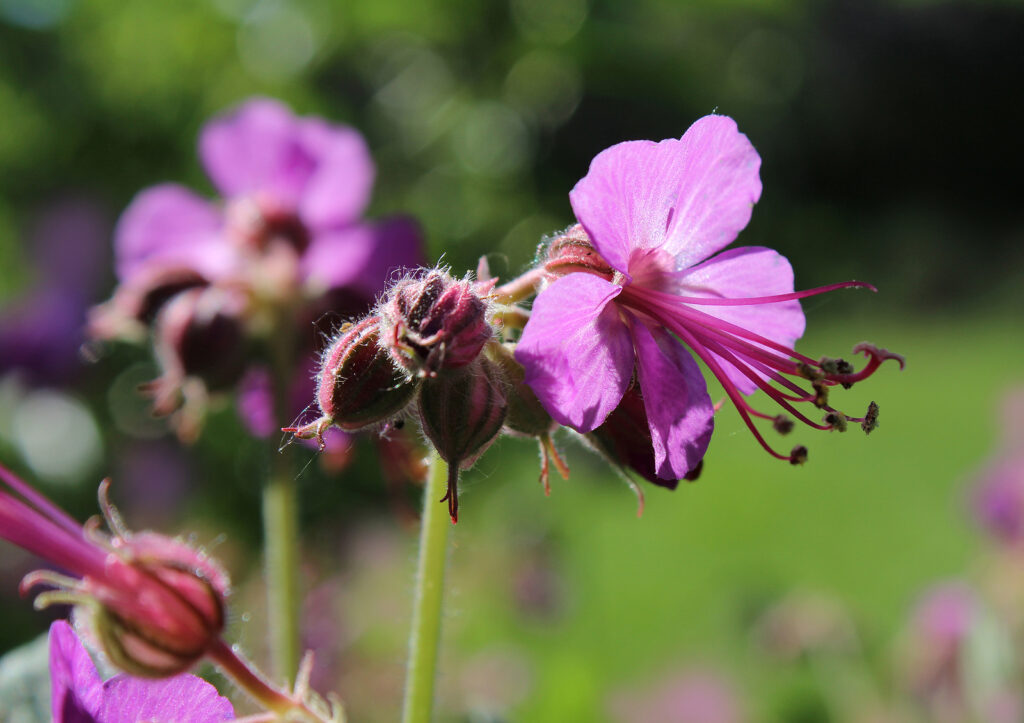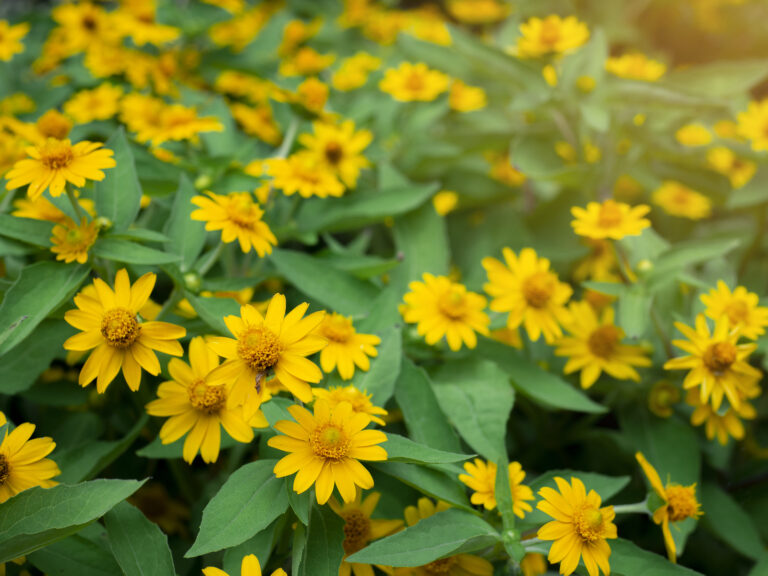How to Grow Cranesbill — Geranium
Geranium species, commonly called hardy geraniums, true geraniums, or cranesbills, are long-lived perennials that produce mounds of foliage and loose clusters of five-petaled cup- or saucer-shaped flowers.
True geraniums are different from common garden geraniums, which are properly called pelargoniums. Hardy, true geraniums, once established, are easy to grow and thrive with little care. They have a good tolerance of cold unlike pelargoniums and are hardy to Zone 3.
The Geranium genus contains about 300 species, including annuals, biennials, and perennials. Perennial species are semi-evergreen to evergreen. They bloom in shades of pink and magenta, as well as white, purple, and violet blue. The main bloom time occurs from late spring to early summer; some rebloom into fall, especially if the plants are cut back.
Geranium leaves are lobed in a palmate fashion and often have toothed or lobed margions. Some speicies have very lacy-texture foliage.

Get to know Geranium
- Plant type: Hardy perennial
- Growing Zones and range: Zones 3 to 8; good cold tolerance and moderate heat tolerance.
- Hardiness: Hardy to -30°F (-34°C); tolerates heat, drought, and harsh winters
- Height and width: 8 to 24 inches (20-61cm) tall; 18 to 24 inches (45-61cm) wide
- Foliage: Leaves are usually rounded or 5-pointed, palmately lobed and divisions are further lobed and toothed; leaves are often aromatic; basal leaves are arranged in rosettes
- Flowers: Single 5-petaled flowers, 1 inch (2.5cm) wide, usually borne in pairs
- Flower colors: Purple, blue, lilac, pink, white
- Bloom time: Summer
- Uses: Small gardens color, ground cover beneath shrubs, along walkways, informal gardens
- Common name: Cranesbill, hardy geranium, true geranium
- Botanical name: Geranium spp.
- Family: Geraniaceae
- Origin: All except very wet habitats around the temperate world

Where to plant Geranium
- Plant hardy geraniums in partial shade or sun. Plant in full sun in Zones 4-6; plant in part shade in Zones 7-8.
- Shade during the hottest part of the day is best.
- Hardy geraniums will grow in almost all soils that are well-drained. Humus-rich soil is best for growing hardy geraniums.
- Hardy geraniums prefer a soil pH of 6 to 7.
Geranium uses and companions
- Use cranesbill Geraniums in flower borders, cottage gardens, and naturalistic gardens.
- Mass-plant Geraniums as ground cover under high-branched trees.
- Good garden companions for Geranium are Alchemilla, Delphinium, Dictamnus albus, Digitalis, Hemerocallis, Lupinus.

When to plant Geranium
- Sow seeds outdoors where you want them to grow 4 weeks before the last frost in spring
- Set hardy geraniums started indoors or purchased from a nursery outdoors in early spring.
Planting and spacing Geranium
- Sow seeds outdoors where you want them to grow; sow seeds 1/2 inch deep and 2 inches (5cm) apart. Germination is slow; allow several week for seedlings to appear.
- Space geraniums 18 inches (45cm) apart.

How to water and feed Geranium
- Keep the soil evenly moist until geraniums are established. After they are established, geraniums are drought tolerant.
- Moist soil aids plants in spreading.
- Fertilize geraniums every 4 to 6 weeks with an all-purpose fertilizer or add slow-release fertilizer each spring. Too much fertilizer can lead to invasive growth.
Geranium care
- Mulch around geraniums to slow soil moisture evaporation.
- Trim back geraniums by half twice during the growing season to keep growth compact and to encourage longer blooming.
- Taller species tend to flop; stake them or let plants sprawl.
- After most flowers fade, cut plants back to 1 inch (2.5cm) above the ground; a fresh new mound will grow in a few weeks.
- Geraniums spread rapidly; divide plants every 2 to 4 years as needed.
- Protect geraniums in winter with 3 to 5 inches (7.6-12cm) of chopped leaves heaped over the plants. Remove the mulch in early spring.
- Geraniums are pest and disease resistant.
Geranium propagation
- Hardy geraniums can be grown from seed; plants readily self sow.
- Geranium seeds germinate in 7 to 10 days at 60° to 70°F (16-21°C); seeds must be refrigerted or exposed to cold for 60 days before sowing.
- Geraniums can be propagated vegetatively–by dividing clump in spring or fall.
- Propagate by cuttings taken from the base of the plant in spring; root cuttings in moist potting mix.

Geranium varieties to grow
- There are numerous species and hybrid cultivars of hardy geraniums.
- Geranium x cantabringiense, Cambridge geranium, mounds to 12 inches (30cm) tall with glossy aromatic leaves; bears purple-pink or white flowers from early to midsummer. ‘Biokovo’ has white flowers tinged pink.
- G. cinereum, grayleaf cranesbill, grows to 12 inches (30cm) tall; bears purplish-pink flowers from late spring to early summer. ‘Ballerina’ has purplish-red flowers. Hardy to -20°F (-20°C).
- G. clarkei, Clark’s geranium, mounds to 18 inches (45cm) tall; bears violet-purple or white flowers with lilac veins from late spring into early summer.
- G. dalmaticum, Dalmatian cranesbill, trails to 2 feet (61cm); bears soft pink flower in spring and early summer; good fall leaves color.
- G. endressii, Cranesbill, mounding to 18 inches (45cm), bears pale pink 1-inch (2.5cm) flowers in spring and blooms all summer, drought tolerant.
- G. himalayense, lilac geranium, clump-forming to 18 inches (45cm) bears violet-blue, 2-inch (5cm) wide flowers. Hardy to -20°F (-20°C).
- G. hybrids, many hybrids include ‘Johnson’s Blue’ that bears lavender-blue flowers.
- G. ibericum, Caucasus geranium bears 2-inch (5cm) violet flowers with dark veins in summer.
- G. macrorrhizum, bigroot geranium, mound-forming to 18 inches (45cm) bears aromatic leaves and pink to purplish 1-inch (2.5cm) flowers.
- G. maculatum, cranesbill, spotted geranium, grows to 24 inches (61cm) bears pink flowers from late spring to mid-summer.
- G. x magnificum, showy geranium, clump-forming to 24 inches (61cm) bears 2 inches (5cm) violet flowers with darker veins in midsummer.
- G. x oxonianum bears pink flowers from spring to fall; variety ‘Wargrave Pink’ has salmon-pink flowers.
- G. phaeum, dusky cranesbill, mourning widow, clump-form to 30 inches (76cm), bears black-purple flowers.
- G. platypetalum, broad-petaled geranium. clump-forming to 18 inches (45cm), bears violet-blue flowers in early to midsummer.
- G. pratense, meadow cranesbill, clump-forming to 36 inches (91cm), bears violet-blue flowers in late spring and early summer.
- G. psilostemon, Armenian cranesbill, shrublike 2 to 4 feet tall, bears 2-inch (5cm) wide magenta flowers with black eyes from early to late summer.
- G. robertianum, called herb-robert, clump-forming to 18 inches (45cm), bears small pink flowers spring to autumn; foliage turns red in autumn.
- G. sanguineum, bloody cranesbill, grows to 12 inches (30cm) tall, lacy leaves, topped by bright pink 1-inch (2.5cm) flowers from spring to summer.
- G. sylvaticum, wood cranesbill, clump-forming to 36 inches (91cm) tall, bears violet,-blue 1-inch (2.5cm) flowers.







